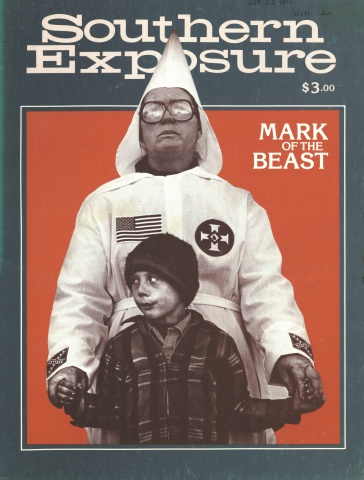Clean Up the Botulism

This article originally appeared in Southern Exposure Vol. 8 No. 2, "Mark of the Beast." Find more from that issue here.
The resurgence of the Ku Klux Klan has to be taken seriously. But I think there are some things that we need to remember as we are discussing that. I am reminded of something Jesus said one time. He was talking to some people, good people, religious people, civic leader-type people, and he said you remind me of folk who wash dishes. They wash the dust and fingerprints off the outside of the bowl, but yesterday’s chili has got botulism and is poisoning their younguns and they don’t even put a dish rag to it. Or you remind me, he said, of the nice painted above the ground, bone-dry resurrection morning out at Woodlawn Cemetery. Nice and pretty, but inside the sepulchres are full of bloated bodies with gaseous guts, rotting, draining out the lower orifices of the torso.
The Ku Klux Klan is certainly the outside of the cup. Jesus didn’t say don’t bother with the outside of the cup. But he did talk about what is inside the sepulchre, too. What is inside the sepulchre where we in Nashville are concerned? What is inside the sepulchre which we sometimes forget in our zeal to stop the menace of the KKK? What is inside — and that we can never forget — is the fact that we as a nation stole this country from the dark-skinned people, killed them or put them in concentration camps to keep them from taking any part of it back, brought some more dark-skinned people to build it, fought world wars to preserve it and to make sure that we got the biggest share of the dark continent that we had brought the people from in the first place — and the Ku Klux Klan had nothing to do with any of it.
What is inside of the sepulchre is that there are more than 600 people appointed to die by the state. A disproportionate number of them are black, and all of them poor, none of them put there by the Ku Klux Klan. Inside the sepulchre are half a million people locked up in prison, a disproportionate number of them black, virtually all of them poor, none of them put there by the Ku Klux Klan. Inside is the fact that when we go to the parking lot tonight, don’t be afraid because we are being protected by the police. I know because I am on the committee that is sponsoring this meeting, and we decided that to protect ourselves from the people we are here discussing in the event they should show up, we should have the police nearby. Inside the sepulchre is the fact that four black people were gunned down in recent weeks, none of them by the Ku Klux Klan. Nobody can ever convince me that if we can capture an elephant alive without shooting it, we can’t capture a fellow is human being alive without shooting it. Particularly if its ^ hands are cuffed in front of its body. What is inside of the sepulchre is that the good jobs are still secured in the normal day-to-day social intercourse in clubs, golf courses, etc., where many black people don’t go with us.
What is inside the sepulchre is the people that we are here talking about, who are so often referred to as crackers and kluxers and woolhats. They are born into the pathology of the white ghetto and are as powerless to get out of it as people born in the black ghetto. In their frustration they join the KKK.
In my judgement what is inside the sepulchre is this. What we are doing here tonight we ought to have done without leaving the other things undone: clean up the botulism. Or another way of putting it might be: Let’s talk about the resurgence of the Ku Klux Klan in the weeks and months to come in this town, but let’s do it in the context of the resurgence of Exxon and J.P. Stevens, and the resurgence of Nashville’s Belle Meade Country Club.
Will Campbell is a preacher from Amite County, Mississippi. He now lives in Mt. Juliet, Tennessee, where he is the Director of the Committee of Southern Churchmen. He has many friends who are Klan members, and he ministers to them as he does his liberal and radical friends. He is the author of Brother to a Dragon Fly, and his writings reflect a keen understanding of the “white ghetto. ” The above is an excerpt of a talk Campbell delivered on April 10, 1980, to a panel on Ku Klux Klan resurgence, sponsored by the Nashville Panel, the Interdenominational Ministerial Fellowship and the Nashville Association of Rabbis, Priests and Ministers, with funding from the Tennessee Committee for the Humanities.
Tags
Will Campbell
Will Campbell is a preacher from Amite County, Mississippi. He now lives in Mt. Juliet, Tennessee, where he is the Director of the Committee of Southern Churchmen. He has many friends who are Klan members, and he ministers to them as he does his liberal and radical friends. He is the author of Brother to a Dragon Fly, and his writings reflect a keen understanding of the “white ghetto.